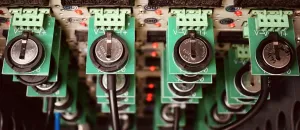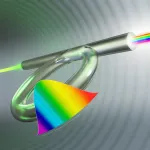Probing the dynamics of photoemission
2021-06-17
(Press-News.org) Physicists at Ludwig-Maximilian University in Munich (LMU) and the Max Planck Institute for Quantum Optics (MPQ) have used ultrashort laser pulses to probe the dynamics of photoelectron emission in tungsten crystals.
Almost a century ago, Albert Einstein received the Nobel Prize for Physics for his explanation of the photoelectric effect. Published in 1905, Einstein's theory incorporated the idea that light is made up of particles called photons. When light impinges on matter, the electrons in the sample respond to the input of energy, and the interaction gives rise to what is known as the photoelectric effect. Light quanta (photons) are absorbed by the material and excite the bound electrons. Depending on the wavelength of the light source, this can result in the ejection of electrons. The electronic band structure of the material involved has a significant effect on the timescales of photoemission. Physicists based at Ludwig-Maximilian University (LMU) in Munich and the Max Planck Institute for Quantum Optics (MPQ) have now taken a closer look at the phenomenon of photoemission. They measured the influence of the band structure of tungsten on the dynamics of photoelectron emission, and provide theoretical interpretations of their observations.
This is now possible thanks to the development and continuing refinement of attosecond technology. An 'attosecond' corresponds to 10-18 of a second, i.e. a billionth of a billionth of a second. The ability to reproducibly generate trains of pulses of laser light that last for a few hundred attoseconds enables researchers to follow the course of photoemission by 'freezing the action' at regular intervals - analogously to a stroboscope, but with far better temporal resolution.
In a series of photoelectron spectroscopy experiments, the team used attosecond pulses of extreme ultraviolet light to probe the dynamics of photoemission from a tungsten crystal. Each pulse contained a few hundred X-ray photons, each energetic enough to dislodge a photoelectron. With the aid of detectors mounted in front of the crystal, the team was able to characterize the ejected electrons in terms of their times of flight and angles of emission.
The results revealed that electrons which interact with incoming photons take a little time to react to such encounters. This finding was made possible by the adoption of a new approach to the generation of attosecond pulses. Thanks to the introduction of a passive cavity resonator with an enhancement factor of 35, the new set-up can now produce attosecond pulses at a rate of 18.4 million per second, approximately 1000-fold higher than that previously common in comparable systems. Because the pulse repetition rate is so high, only very few photoelectrons per pulse are sufficient to provide a high average flux.
"Since the negatively charged photoelectrons repel one another, their kinetic energies are subject to rapid change. In order to characterize their dynamics, it's therefore important to distribute them over as many attosecond pulses as possible," as joint first author Dr. Tobias Saule explains. The increased pulse rate means the particles have little opportunity to interact with each other because they are well distributed in time and space, so that the maximal energy resolution is largely retained. In this way, the team was able to show that, in terms of the kinetics of photoemission, electrons in neighboring energy states in the valence band (i.e. the outermost orbits of the atoms in the crystal), which have different angular momenta also differ by a few tens of attoseconds in the time they take to respond to incoming photons.
Notably, the arrangement of the atoms within the crystal itself has a measurable influence on the delay between the arrival of the light pulse and the ejection of photoelectrons. "A crystal is made up of multitudes of atoms, all of whose nuclei are positively charged. Each nucleus is the source of an electrical potential, which attracts the negatively charged electrons - in the same way as a round hole acts as a potential well for marbles," says Dr. Stephan Heinrich, also joint first author of the report. "When an electron is dislodged from a crystal, what happens is a bit like the progress of a marble across a table that is pitted with depressions.
These indentations represent the positions of the individual atoms in the crystal, and they are regularly organized. The trajectory of the marble is directly affected by their presence, and it differs from what would be observed on a smooth surface," he points out. "We have now demonstrated how such a periodic potential within a crystal affects the temporal behavior of photoemission - ¬and we can theoretically account for it," Stephan Heinrich explains. The delays observed can be attributed to the complex nature of electron transport from the interior to the surface of the crystal, and to the impact of the electron scattering and correlation effects that this entails.
"The insights provided by our study open up the possibility of experimental investigations of the complex interactions that take place in multi-electron systems in condensed matter on an attosecond timescale. This in turn will enable us to understand them theoretically," says LMU-Prof. Ulf Kleineberg, who led the project.
In the longer term, the new findings could also lead to novel materials with electronic properties that enhance light-matter interactions, which would make solar cells more efficient, and improve switching rates of nano-optical components for ultrafast data processing and promote the development of nanosystems for use in the biomedical sciences.
INFORMATION:
ELSE PRESS RELEASES FROM THIS DATE:
2021-06-17
Lugano, Switzerland, 17 June 2021 - Adding an immune checkpoint inhibitor to anti-HER2 treatment in breast cancer does not improve pathological complete response (pCR), according to the primary analysis of the IMpassion050 trial presented today during the ESMO Virtual Plenary. (1) The phase III trial is the first to report data comparing a neoadjuvant anti-HER2 based regimen with or without the anti-PD-L1 antibody atezolizumab in patients with high-risk, HER2-positive early breast cancer.
The standard treatment for high-risk, HER2-positive early breast cancer is dual anti-HER2 blockade plus chemotherapy. While antibody therapy may enhance innate and adaptive immunity and activate cellular cytotoxicity, there is evidence ...
2021-06-17
(Boston)--An intrauterine fracture is a rare finding during routine prenatal imaging. This condition can be due to maternal trauma, genetic disorders of the skeleton, as well as other predisposing maternal metabolic and vascular disorders. Genetic disorders that have previously been reported to cause intrauterine fracture include brittle bone disease (osteogenesis imperfecta or OI), osteopetrosis, hypophosphatasia and Ehlers-Danlos syndrome (EDS).
Now for the first time, researchers from Boston University School of Medicine (BUSM) report a new genetic cause, unrelated to OI, for the 23 fractures that occurred in-utero to a mother with EDS hypermobility type.
EDS is a disease that weakens the bones and connective tissues ...
2021-06-17
New study challenges long-standing assumptions about disease severity in infants, and suggests that standard qPCR interpretations underestimate the true burden of other highly contagious diseases, such as COVID-19 and influenza.
Pertussis, also known as "whooping cough," remains a significant cause of death in infants and young children around the world and, despite global vaccination programs, many countries are experiencing a resurgence of this highly contagious disease.
A new study by Boston University School of Public Health and the University of Georgia's Odum School of Ecology presents evidence that could help explain this ...
2021-06-17
Bottom Line: Genetic mutations indicative of DNA damage were associated with high red meat consumption and increased cancer-related mortality in patients with colorectal cancer.
Journal in Which the Study was Published: Cancer Discovery, a journal of the American Association for Cancer Research
Author: Marios Giannakis, MD, PhD, an assistant professor of medicine at Harvard Medical School and a physician at Dana-Farber Cancer Institute
Background: "We have known for some time that consumption of processed meat and red meat is a risk factor for colorectal cancer," said Giannakis. The International Agency for Research on Cancer declared that processed meat was carcinogenic and that red meat was probably carcinogenic to humans in 2015.
Experiments ...
2021-06-17
HOUSTON ? Preclinical research from The University of Texas MD Anderson Cancer Center finds that although glioblastoma stem cells (GSCs) can be targeted by natural killer (NK) cells, they are able to evade immune attack by releasing the TFG-β signaling protein, which blocks NK cell activity. Deleting the TFG-β receptor in NK cells, however, rendered them resistant to this immune suppression and enabled their anti-tumor activity.
The findings, published today in the Journal of Clinical Investigation, suggest that engineering NK cells to resist immune suppression may be a feasible path ...
2021-06-17
The energy density of traditional lithium-ion batteries is approaching a saturation point that cannot meet the demands of the future - for example in electric vehicles. Lithium metal batteries can provide double the energy per unit weight when compared to lithium-ion batteries. The biggest challenge, hindering its application, is the formation of lithium dendrites, small, needle-like structures, similar to stalagmites in a dripstone cave, over the lithium metal anode. These dendrites often continue to grow until they pierce the separator membrane, causing the battery to short-circuit and ultimately destroying ...
2021-06-17
Nitrogen from agriculture, vehicle emissions and industry is endangering butterflies in Switzerland. The element is deposited in the soil via the air and has an impact on vegetation - to the detriment of the butterflies, as researchers at the University of Basel have discovered.
More than half of butterfly species in Switzerland are considered to be at risk or potentially at risk. Usually, the search for causes focuses on intensive agriculture, pesticide use and climate change. A research team led by Professor Valentin Amrhein from the University of Basel, however, has been investigating another factor - the depositing ...
2021-06-17
Living beings are continuously exposed to harmful agents, both exogenous (ultraviolet radiation, polluting gases, etc.) and endogenous (secondary products of cellular metabolism) that can affect DNA integrity. That's why cells are endowed with a series of molecular mechanisms whose purpose is to identify and signpost possible damage to the genetic material for speedy repair. These mechanisms are precisely regulated because they are key to cell survival. In extreme situations of massive and irreparable damage, cells enter a phase of controlled dismantling called "programmed cell death". Among the events that take place during this process is the massive delivery to the cytoplasm of a mitochondrial protein called cytochrome C. Under homeostatic conditions, this protein plays a role in energy ...
2021-06-17
The 2018 Nobel Prize in Physics was shared by researchers who pioneered a technique to create ultrashort, yet extremely high-energy laser pulses at the University of Rochester.
Now researchers at the University's Institute of Optics have produced those same high-powered pulses--known as chirped pulses--in a way that works even with relatively low-quality, inexpensive equipment. The new work could pave the way for:
Better high-capacity telecommunication systems
Improved astrophysical calibrations used to find exoplanets
Even more accurate atomic clocks
Precise devices for measuring chemical contaminants in the atmosphere
In a paper in Optica, the researchers describe the first demonstration ...
2021-06-17
Peatlands are an important ecosystem that contribute to the regulation of the atmospheric carbon cycle. A multidisciplinary group of researchers, led by the University of Helsinki, investigated the climate response of a permafrost peatland located in Russia during the past 3,000 years. Unexpectedly, the group found that a cool climate period, which resulted in the formation of permafrost in northern peatlands, had a positive, or warming, effect on the climate.
The period studied, which began 3,000 years ago, is known as a climate period of cooling temperatures. The climate-related effect of permafrost formation brought about by the cooling was investigated particularly by analysing the ancient plant communities of the peatland, using similarly analysed peatland data from elsewhere in ...
LAST 30 PRESS RELEASES:
[Press-News.org] Probing the dynamics of photoemission




